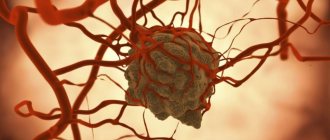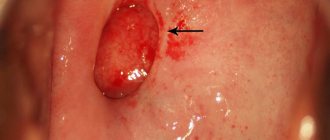Composition of Ovestin
The main component of Ovestin is estriol. This is a hormone, the deficiency of which in the body affects the condition of the mucous membranes of the genitourinary system. For suppositories, an additional component is vitepsol, as the most common base for the production of suppositories.
Other auxiliary components are used for the cream to achieve a soft absorbent texture: glycerol, lactic acid, sodium hydroxide, octyldodecanol, sorbitan stearate, purified water.
The effectiveness of both forms of the drug is due to the presence of estriol.
Action of Ovestin
Ovestin is indicated for women during menopause. At this time, a woman’s body undergoes a radical restructuring, the level of hormone production changes, which affects both mood and well-being. Menopause is often accompanied by hot flashes - sudden sweating. At this time, the woman experiences discomfort for most of the day. She may be tormented by a headache, unreasonable irritability, a feeling of cold or, conversely, stuffiness in the room. All this is complemented by physical discomfort in the intimate area.
Due to an imbalance of hormones, the mucous membranes of the genital organs cannot cope with the function of moisturizing. This causes itching and even burning in the groin. Ovestin successfully combats these symptoms. Working locally, it does not allow the vaginal walls to dry out, which means it increases local immunity. Thanks to this, it is possible to avoid infection with sexually transmitted infections that cause vaginitis, urinary incontinence and inflammation of the genitourinary tract.
Using Ovestin restores the joy of life, relieves discomfort and pain during sexual intercourse. A woman forgets about itching and burning in the intimate area, which means there are fewer reasons for irritability.
Ovestin, cream vag. tube 15g (Aspen, GERMANY)
Composition and release form.
1 tablet contains estriol 2 mg; 30 pcs in a blister, 1 blister in a cardboard box.
1 g vaginal cream - 1 mg; in tubes of 15 g complete with an applicator, 1 set in a cardboard box.
1 vaginal suppository - 0.5 mg;
5 pcs in a blister, 3 blisters in a cardboard box. Pharmachologic effect. Estrogenic.
Restores the vaginal epithelium, helps normalize the pH of the environment and microflora in the vagina, thereby increasing the resistance of the vaginal epithelium to infectious and inflammatory processes.
Pharmacodynamics.
Since estriol interacts with the nuclei of endometrial cells for a short time, taking it in recommended doses does not cause endometrial proliferation and does not require additional therapy with progestogens (withdrawal bleeding does not occur).
Pharmacokinetics.
When used orally and topically, it is quickly and almost completely absorbed. Cmax is achieved 1 hour after oral administration and 1–2 hours after intravaginal use. It is excreted primarily by the kidneys in conjugated form, 2% is excreted unchanged through the intestines.
Indications.
Atrophy of the mucous membrane of the lower parts of the genitourinary tract caused by estrogen deficiency: dryness and itching in the vagina, pain during sexual intercourse, frequent painful urination, chronic cystitis, urinary incontinence upon urge; pre- and postoperative therapy in postmenopausal women during surgical interventions via vaginal access; unclear results of a cytological examination of the cervix (suspicion of a tumor process) against the background of atrophic changes (for diagnostic purposes).
Contraindications.
Hypersensitivity, estrogen-dependent tumor (diagnosed or suspected), vaginal bleeding of unknown etiology; thrombosis (venous and arterial), incl. history, pregnancy.
Use during pregnancy and breastfeeding.
Contraindicated during pregnancy.
Side effects.
Breast tenderness or tenderness, nausea, focal pigmentation, hypersecretion of cervical mucus; rarely - headache, arterial hypertension, calf muscle cramps, blurred vision; local irritation or itching (cream).
Method of administration and dose.
Pills:
orally, daily, 4 mg once a day for 3 weeks, then gradually reduce the dose to 2 mg per week.
Cream:
intravaginally, 1 dose (using a calibrated applicator), daily before bedtime for 3 weeks, then gradually reduce the dose to 1 administration per week.
Suppositories:
intravaginally, 1 supp. daily before bed for 3 weeks, then gradually reduce the dose to 1 supp. in Week.
Precautionary measures.
Close monitoring of patients with a history of thromboembolic disease, severe renal impairment, porphyria, severe itching or cholestatic jaundice during previous pregnancies or taking steroid drugs, gestational herpes, or otosclerosis is recommended.
Special instructions.
When taking Ovestin, an annual medical examination is recommended.
Instructions for use
It is recommended to use suppositories once a day, preferably at night. During 6-8 hours of sleep, the hormone from the suppositories is released and replenishes the estrogen deficiency.
If the prescription of Ovestin is associated with the treatment of atrophy of the mucous membranes of the vagina and urinary tract, the following treatment regimen is indicated: one suppository every night for two weeks. With a clear decrease in symptoms, reduce the dose and gradually increase to 2 suppositories per week.
If a woman who has reached the age of menopause is being prepared for surgery, two weeks before the intervention, 1 suppository is prescribed daily. After surgery, it is necessary to continue treatment at a dosage of 1 suppository twice a week for 14 days.
When diagnosis through a cytological smear is difficult, 1 suppository is prescribed every other day for a week before taking the material.
Important! If a woman has forgotten to put the suppository on schedule, she needs to continue treatment from the day she remembered to take her course. It is not permissible to make up for missed doses by increasing the daily dosage. After an accidental break, therapy is continued as before.
Ovestin®
— To treat menopausal symptoms, HRT should only be prescribed for symptoms that adversely affect quality of life. In all cases, a thorough assessment of the risks and benefits of treatment should be carried out at least once a year, and HRT should be continued only as long as the benefits outweigh the risks.
— There is limited evidence of the risks of HRT when treating premature menopause. Due to the lower absolute risk in younger women, the benefit-risk ratio is more favorable in them than in older women.
Medical examination/observation
— Before starting or resuming HRT, it is necessary to obtain a detailed individual and family history. Guided by the obtained medical history, contraindications and warnings for use, it is necessary to conduct a clinical examination, including examination of the pelvic organs and mammary glands. During treatment, it is recommended to conduct periodic medical examinations, the frequency and nature of which vary from person to person. Women should be informed about the need to tell their doctor about changes in the mammary glands (see “Breast cancer” below). Investigations, including appropriate imaging modalities such as mammography, should be performed in accordance with currently accepted examination standards and on a case-by-case basis.
Reasons for immediate discontinuation of therapy:
Therapy should be discontinued if contraindications are identified and if the following conditions occur:
- Jaundice or deterioration of liver function;
- Significant increase in blood pressure;
— The occurrence of migraine-type headaches;
- Pregnancy.
Endometrial hyperplasia and carcinoma
— To prevent stimulation of the endometrium, the daily dose of the drug should not be divided into several doses and should not exceed 8 mg of estriol. In addition, one epidemiological study found that long-term use of low-dose estriol may increase the risk of endometrial cancer. The risk increases with the duration of treatment and returns to baseline values one year after discontinuation of the drug. Basically, the risk of minimally invasive and well-differentiated tumors increases.
For women with an intact uterus, the following precautions are recommended:
- The entire daily dose must be taken at once;
— The patient should be informed of the need to contact the attending physician if vaginal bleeding begins (this symptom in all cases requires examination);
- With long-term treatment, the condition of the endometrium must be assessed at least once a year, or progestogens must be prescribed for at least 12-14 days of each calendar month.
When deciding whether to control the condition of the endometrium or to prescribe progestogens, the increased risk of breast cancer with combined therapy with estrogens and progestogens should be taken into account. There is currently no evidence that estrogen monotherapy increases the risk of breast cancer.
Mammary cancer
— Hormone replacement therapy may increase mammographic density. This can make radiological detection of breast cancer more difficult. Clinical studies have shown that the likelihood of developing increased mammographic density was lower in patients treated with estriol than in patients treated with other estrogens.
— Pooled evidence suggests an increased risk of breast cancer in women receiving combination therapy with estrogens and progestogens and possibly estrogen monotherapy.
— In women receiving combination therapy with estrogens and progestogens for more than 5 years, there was a 2-fold increase in the risk of breast cancer.
— With estrogen monotherapy, any increase in risk is significantly lower than when combined with progestogens.
— The level of risk depends on the duration of HRT.
— It is unknown whether Ovestin® poses the same risk. A recent population-based case-control study of 3345 women with invasive breast cancer and 3454 controls showed that estriol use, unlike other estrogens, was not associated with an increased risk of breast cancer. It is therefore important that the risk of developing breast cancer is discussed with the patient and weighed against the known benefits of HRT.
Ovarian cancer
— Ovarian cancer develops much less frequently than breast cancer. Long-term estrogen monotherapy (at least 5-10 years) was associated with a small increase in the risk of ovarian cancer. Some studies suggest that combined HRT may increase the risk of ovarian cancer in a similar or small way. It is not known whether the risk of long-term use of low-potency estrogens (such as Ovestin®) differs from that of monotherapy with other estrogens.
Venous thromboembolism
— HRT is associated with an increased risk of developing venous thromboembolism (VTE), i.e. deep vein thrombosis or pulmonary embolism, 1.3 - 3 times. VTE is more likely to occur during the first year of HRT use than later in life. A similar risk is not known for Ovestin®.
— In patients with confirmed thrombophilia, the risk of VTE is high, and HRT may further increase it. In this regard, HRT is contraindicated for such women (see section “Contraindications”).
— Commonly recognized risk factors for VTE include estrogen use, older age, major surgery, prolonged immobilization, obesity (BMI > 30 kg/m2), pregnancy/puerperium, systemic lupus erythematosus, and cancer. Not regarding the possible role of varicose veins in the development of VTE. After any surgical intervention, VTE prophylaxis is necessary. If prolonged immobilization is associated with elective surgery, it is necessary to temporarily discontinue HRT 4-6 weeks before surgery. Treatment should be resumed after the woman begins to walk.
— If Ovestin® is prescribed as “pre- and postoperative treatment,” the issue of thrombosis prevention should be considered.
— In the absence of a history of VTE, but in the presence of thrombosis at a young age in the patient’s closest relatives, she can be offered a screening examination, having previously discussed all its limitations (screening can only identify a number of thrombophilic disorders). If a thrombophilic defect is detected that does not correspond to the disease in relatives, or if a “severe” defect is detected (for example, deficiency of antithrombin, protein S or protein C, or a combination of these defects), HRT is contraindicated.
— For women already receiving anticoagulant treatment, careful consideration of the benefit-risk ratio of HRT is required.
— If VTE develops after starting treatment with Ovestin®, then treatment with the drug must be stopped. Patients should be informed to seek immediate medical attention if they experience possible signs of thromboembolism (eg, painful leg swelling, sudden chest pain, shortness of breath).
Coronary heart disease (CHD)
— In randomized controlled trials, there were no results that would indicate that combination therapy with estrogens and progestogens and estrogen monotherapy can prevent the development of myocardial infarction in women with and without coronary artery disease.
Estrogen monotherapy:
— According to randomized controlled trials in women with a removed uterus, the risk of coronary heart disease does not increase with estrogen monotherapy.
— The risk of coronary heart disease increases slightly with combined HRT with estrogens and progestogens in patients over 60 years of age.
Ischemic stroke
— Combination therapy with estrogens and progestogens and monotherapy with estrogens are associated with a 1.5-fold increase in the risk of ischemic stroke. The relative risk does not change with age or time after menopause. However, the baseline risk of stroke is highly dependent on age, and the overall risk of stroke with HRT increases with age. The risk of hemorrhagic stroke does not increase with HRT;
Other states
— Estrogens can cause fluid retention, so patients with impaired renal function and cardiovascular insufficiency should be under close medical supervision.
— Estriol is a weak gonadotropin antagonist and does not have other significant effects on the endocrine system.
— Cognitive function does not improve with HRT. Evidence was obtained of an increased risk of developing dementia in women who began using combination therapy or monotherapy in a continuous mode after 65 years of age.
Ovestin cream - instructions
The use of the cream is made easier by the included applicator. It helps to dose the cream correctly for one-time use of the product. To measure out 0.5 g of cream, just pour it into the applicator up to the special mark.
When treating atrophy of the mucous membranes, 1 dose of cream is administered using an applicator at night. It is permissible to use the product daily for a month. After the fourth week of use, gradually reduce the dose to 1 twice a week.
Before the scheduled operation, take 1 dose every evening for two weeks. In the postoperative period, reduce the dosage to 1 application twice a week. Therapy is continued for 14 days.
Before performing a cytological examination of the cervix, 1 application is administered every other day a week before taking the material.
When using this form of Ovestin, do not forget that the applicator must be rinsed under running water after each use. It is unacceptable to boil water to disinfect the applicator.
Ovestin suppositories 0.5 mg No. 15
special instructions
To treat menopausal symptoms, HRT should only be started for symptoms that adversely affect quality of life.
In all cases, a thorough assessment of the risks and benefits of treatment should be carried out at least once a year and HRT should be continued only as long as the benefits outweigh the risks. There is limited evidence of the risk development of HRT when treating premature menopause. Because younger women have a lower absolute risk, their benefit-risk ratio is more favorable than that of older women.
Medical examination/observation
Before starting or resuming HRT, a detailed individual and family history should be obtained. Guided by the obtained medical history, contraindications and warnings for the use of the drug, it is necessary to conduct a clinical examination, including examination of the pelvic organs and mammary glands. During treatment, it is recommended to conduct periodic medical examinations, the frequency and nature of which vary from person to person, but at least once a year. Women should be informed about the need to tell their doctor about changes in the mammary glands (see section “Breast cancer” below). Investigations, including appropriate imaging modalities such as mammography, should be performed in accordance with currently accepted screening standards and on a case-by-case basis.
Reasons for immediate discontinuation of therapy
Therapy should be discontinued if a contraindication is identified and if the following conditions occur:
Jaundice or deterioration of liver function.
Significant increase in blood pressure.
The occurrence of a migraine-type headache.
Pregnancy.
Endometrial hyperplasia and carcinoma
To prevent endometrial stimulation, the daily dose of the drug should not exceed 1 application (0.5 mg estriol). This maximum dose should not be used for more than 4 weeks. In addition, one epidemiological study found that long-term use of low-dose estriol, administered orally but not intravaginally, may increase the risk of endometrial cancer. The risk increases with the duration of treatment and returns to baseline values one year after discontinuation of the drug. The risk of minimally invasive and well-differentiated tumors mainly increases. Vaginal bleeding in all cases requires examination. The patient should be informed of the need to contact the attending physician if vaginal bleeding begins.
Mammary cancer
Hormone replacement therapy may increase mammographic density. This can make radiological detection of breast cancer more difficult. Clinical studies have shown that the likelihood of an increase in mammographic density is lower in women treated with estriol than in women treated with other estrogens.
Composite evidence suggests an increased risk of breast cancer in women receiving combination therapy with estrogens and progestogens and possibly estrogen monotherapy.
In women receiving combination therapy with estrogens and progestogens for more than 5 years, a 2-fold increase in the risk of breast cancer was noted.
With estrogen monotherapy, the increase in risk is significantly lower than when combined with progestogens.
The level of risk depends on the duration of HRT.
A similar risk is not known for Ovestin®. A recent population-based case-control study of 3345 women with invasive breast cancer and 3454 controls showed that estriol use, unlike other estrogens, was not associated with an increased risk of breast cancer. It is therefore important that the risk of developing breast cancer is discussed with the patient and weighed against the known benefits of HRT.
Ovarian cancer
Ovarian cancer develops much less frequently than breast cancer. Long-term estrogen monotherapy (at least 5–10 years) was associated with a small increase in the risk of ovarian cancer. Some studies suggest that combined HRT may increase the risk of ovarian cancer in a similar or small way. It is not known whether the risk of long-term use of low-potency estrogens (such as Ovestin®) differs from that of monotherapy with other estrogens.
Venous thromboembolism
HRT is associated with an increased risk of venous thromboembolism (VTE), i.e. deep vein thrombosis or pulmonary embolism, 1.3 – 3 times. The likelihood of developing VTE is higher during the first year of HRT use than at a later date. A similar risk is not known for Ovestin®.
In patients with confirmed thrombophilia, the risk of VTE is high, and HRT may further increase this risk. In this regard, HRT is contraindicated for such women (see section “Contraindications”).
Commonly recognized risk factors for VTE include estrogen use, older age, major surgery, prolonged immobilization, obesity (BMI > 30 kg/m2), pregnancy/puerperium, systemic lupus erythematosus, and cancer. There is no consensus regarding the possible role of varicose veins in the development of VTE. After any surgical intervention, VTE prophylaxis is necessary. If prolonged immobilization is associated with elective surgery, it is necessary to temporarily discontinue HRT 4–6 weeks before surgery. Treatment should be resumed after the woman begins to walk.
For women already receiving anticoagulant treatment, careful consideration of the benefit-risk balance of HRT is required.
If Ovestin® is prescribed as “pre- and postoperative treatment...”, the issue of thrombosis prophylaxis should be considered.
In the absence of a history of VTE, but in the presence of thrombosis at a young age in the patient’s closest relatives, she can be offered a screening examination, having previously discussed all its limitations (screening can detect only a number of thrombophilic disorders). If a thrombophilic defect is detected that does not correspond to the disease in relatives, or if a “severe” defect is detected (for example, deficiency of antithrombin, protein S or protein C, or a combination of these defects), HRT is contraindicated.
If VTE develops after starting treatment with Ovestin®, treatment should be discontinued. Patients should be informed to seek immediate medical attention if they experience possible signs of thromboembolism (eg, painful leg swelling, sudden chest pain, shortness of breath).
Coronary heart disease (CHD)
Randomized controlled trials did not provide results that would indicate that combination therapy with estrogens and progestogens and estrogen monotherapy can prevent the development of myocardial infarction in women with and without coronary artery disease.
Estrogen monotherapy:
According to randomized controlled trials, the risk of coronary heart disease in women with a removed uterus does not increase with estrogen monotherapy.
The risk of coronary heart disease increases slightly with combined HRT with estrogens and progestogens in patients over 60 years of age.
Ischemic stroke
Combination therapy with estrogens and progestogens and monotherapy with estrogens are associated with a 1.5-fold increase in the risk of ischemic stroke. The relative risk does not change with age or time after menopause. However, the baseline risk of stroke is highly dependent on age, and the overall risk of stroke with HRT increases with age. The risk of hemorrhagic stroke does not increase with HRT.
Other states
Estrogens can cause fluid retention and therefore patients with impaired renal function and cardiovascular insufficiency should be closely monitored.
Estriol is a weak gonadotropin antagonist and has no other significant effects on the endocrine system.
Cognitive function does not improve with HRT. Evidence was obtained of an increased risk of developing dementia in women who began using combination therapy or monotherapy in a continuous regimen after 65 years.
The drug contains cetyl alcohol and stearyl alcohol, which can cause local skin reactions (for example, contact dermatitis).
Impact on the ability to drive vehicles and machinery
There was no effect of the drug Ovestin® on concentration and attention.
Possible side effects of Ovestin
Ovestin cream, like suppositories, when in contact with the mucous membrane of the female genital organs, can cause mild irritation and even burning. As a rule, this feeling passes. Replenishment of the lack of hormones is neutralized, and along with it, the unpleasant sensations associated with the administration of the very first dose of the drug disappear.
When it comes to hormone therapy, there is always a risk of developing cancer. Ovestin, if dosed incorrectly and if the dosage regimen is not followed, can cause endometrial cancer or malignant neoplasms of the mammary gland. In addition, non-cyclical bleeding may occur.
Ovestin 0.5 mg, 15 vaginal suppositories
Registration Certificate Holder
ASPEN PHARMA TRADING (Ireland)
Dosage form
Medicine - Ovestin® (Ovestin)
Description
Vaginal suppositories
torpedo-shaped from white to light cream; the surface and longitudinal section are uniform.
1 sup.
estriol 0.5 mg
Excipients
: vitepsol S58 - 2.4995 g.
5 pieces. — cellular contour packages (3) — cardboard packs.
Indications
- hormone replacement therapy (HRT) for the treatment of atrophy of the mucous membrane of the lower genitourinary tract associated with estrogen deficiency in postmenopausal women;
- pre- and postoperative therapy for postmenopausal women during surgical interventions with vaginal access;
- as an auxiliary diagnostic tool when obtaining an atrophic picture of a cervical smear.
Contraindications for use
- known, known or suspected breast cancer;
- diagnosed or suspected estrogen-dependent tumors (for example, endometrial cancer);
- bleeding from the vagina of unknown etiology;
- untreated endometrial hyperplasia;
- the presence of venous thrombosis currently and in history (deep vein thrombosis, pulmonary thromboembolism);
- confirmed thrombophilias (for example, deficiency of protein C, protein S or antithrombin (see section "Special instructions"));
- thrombosis (venous and arterial) and thromboembolism currently or in history (including deep vein thrombosis, pulmonary embolism, myocardial infarction, stroke), cerebrovascular disorders; conditions preceding thrombosis (including transient ischemic attacks, angina) currently or in history;
- acute liver disease or a history of liver disease after which liver function tests have not returned to normal;
- established hypersensitivity to the active substance or to any of the excipients of the drug;
- porphyria.
Carefully
Ovestin® should be used with caution (under close medical supervision) if any of the following diseases or conditions are present, or these diseases or conditions have previously been noted and/or worsened during previous pregnancies or previous hormonal treatment (as they may recur or worsen during treatment with Ovestin®):
- leiomyoma (uterine fibroids) or endometriosis;
- risk factors for thromboembolism (see section “Special instructions”);
- risk factors for estrogen-dependent tumors, for example, 1st degree of heredity for breast cancer;
- arterial hypertension;
- benign liver tumors (for example, liver adenoma);
- diabetes mellitus with or without diabetic angiopathy;
- cholelithiasis;
- jaundice (including a history during a previous pregnancy);
- liver failure;
- migraine or (severe) headache;
- systemic lupus erythematosus;
- history of endometrial hyperplasia (see section “Special instructions”);
- epilepsy;
- bronchial asthma;
- otosclerosis;
- familial hyperlipoproteinemia;
- pancreatitis.
pharmachologic effect
The drug Ovestin® contains estriol, an analogue of the natural female hormone. It replenishes estrogen deficiency in postmenopausal women and reduces postmenopausal symptoms. Estriol is most effective in the treatment of genitourinary disorders. In case of atrophy of the mucous membrane of the lower parts of the genitourinary tract, estriol helps to normalize the epithelium of the genitourinary tract and helps restore normal microflora and physiological pH in the vagina. As a result, it increases the resistance of epithelial cells of the genitourinary tract to infection and inflammation, reducing complaints such as pain during sexual intercourse, dryness, itching in the vagina, reduces the likelihood of vaginal infections and urinary tract infections, helps normalize urination and prevents urinary incontinence.
Unlike other estrogens, estriol has a short period of action, since it is retained in the nuclei of endometrial cells for a short period of time. It is assumed that a single daily dose does not cause endometrial proliferation. Therefore, cyclic administration of progestogen is not required and withdrawal bleeding does not occur. In addition, estriol has not been shown to increase mammographic density.
Drug interactions
In clinical practice, no interaction has been observed between the drug Ovestin® and other drugs.
The metabolism of estrogens may be enhanced when used in combination with compounds that induce enzymes involved in drug metabolism, particularly cytochrome P450 isoenzymes, such as anticonvulsants (phenobarbital, phenytoin, carbamazepine) and antimicrobial agents (rifampicin, rifabutin, nevirapine, efavirenz).
Ritonavir and nelfinavir exhibit inducing properties when used in combination with steroid hormones.
Herbal preparations containing St. John's wort (Hypericum perforatum) may induce estrogen metabolism.
Increased metabolism of estrogens may lead to a decrease in their clinical effect.
Estriol enhances the effect of lipid-lowering drugs; weakens the effects of male sex hormones, anticoagulants, antidepressants, diuretics, antihypertensives, hypoglycemic agents.
Medicines for general anesthesia, narcotic analgesics, anxiolytics, some antihypertensive drugs, ethanol reduce the effectiveness of the drug.
Folic acid and thyroid medications enhance the effects of estriol.
Dosage regimen
Ovestin® suppositories should be inserted into the vagina at night before bed.
In the treatment of atrophy of the mucous membrane of the lower genitourinary tract
Prescribe 1 suppository/day for the first weeks, followed by a gradual reduction in dose, based on symptom relief, until a maintenance dose is reached (i.e., 1 suppository 2 times a week).
For pre- and postoperative therapy of postmenopausal women, during surgical interventions via vaginal access
prescribe 1 suppository/day for 2 weeks before surgery; 1 suppository 2 times a week for 2 weeks after surgery.
For diagnostic purposes in case of unclear results of cytological examination of the cervix
Prescribe 1 suppository every other day for a week before taking the next smear.
If a dose is missed, the missed dose must be administered on the same day as soon as the patient remembers it (the dose should not be administered 2 times a day). Subsequent applications are carried out in accordance with the usual dosage regimen.
When initiating or continuing treatment for postmenopausal symptoms, use the lowest effective dose for the shortest possible duration.
In women not receiving HRT, or women who are switching from continuous use of an oral combination drug for HRT, treatment with Ovestin® can be started on any day. Women who are switching from a cyclic regimen of HRT medications should begin treatment with Ovestin® 1 week after stopping HRT medications.
Overdose
The acute toxicity of estriol in animals is very low. An overdose of Ovestin® when administered vaginally is unlikely. However, if large quantities of the drug enter the gastrointestinal tract, nausea, vomiting and cessation of bleeding in women may develop.
Treatment:
there is no specific antidote. If necessary, symptomatic treatment should be carried out.
Side effect
As with any other drug that is applied to the surface of the mucous membranes, Ovestin® suppositories can sometimes cause local irritation or itching.
Sometimes
There may be sensitivity, tension, soreness, and an increase in the size of the mammary glands. These undesirable reactions are usually short-lived and passing, but at the same time may indicate the use of too high a dose.
Also found: acyclic spotting, breakthrough bleeding, metrorrhagia.
Other adverse reactions have been reported during estrogen monotherapy or combination therapy with estrogens and progestogens.
From the liver and biliary tract:
cholelithiasis.
Benign, malignant and unspecified neoplasms (including cysts and polyps):
benign and malignant estrogen-dependent neoplasia, incl. endometrial cancer (for additional information, see the sections “Contraindications” and “Special Instructions”).
Mental disorders:
dementia when starting HRT in a continuous mode after 65 years (see section “Special instructions”).
From the genital organs and breast:
increased libido.
From the skin and subcutaneous tissues:
chloasma, erythema multiforme, erythema nodosum, hemorrhagic purpura.
There is data on the development of the risk of breast cancer, ovarian cancer, the risk of venous thromboembolism, the risk of coronary artery disease, and the risk of ischemic stroke (detailed information is provided in the “Special Instructions” section).
special instructions
To treat menopausal symptoms, HRT should only be started for symptoms that adversely affect quality of life. In all cases, a thorough assessment of the risks and benefits of treatment should be carried out at least once a year and HRT should be continued only as long as the benefits outweigh the risks.
There is limited evidence of the risk development of HRT when treating premature menopause. Because younger women have a lower absolute risk, their benefit-risk ratio is more favorable than that of older women.
Medical examination/observation
Before starting or resuming HRT, a detailed individual and family history should be obtained. Based on the obtained medical history, contraindications and warnings for use, it is necessary to conduct a clinical examination (including examination of the pelvic organs and mammary glands). During treatment, it is recommended to conduct periodic medical examinations, the frequency and nature of which vary from person to person. Women should be informed about the need to tell their doctor about changes in the mammary glands (see “Breast cancer” below). Investigations, including appropriate imaging modalities such as mammography, should be performed in accordance with currently accepted screening standards and on a case-by-case basis.
Reasons for immediate discontinuation of therapy
Therapy should be discontinued if a contraindication is identified and/or if the following conditions occur:
- jaundice and/or deterioration of liver function;
- significant increase in blood pressure;
- resumption of migraine-type headaches;
- pregnancy.
Endometrial hyperplasia and carcinoma
To prevent stimulation of the endometrium, the daily dose of the drug should not exceed 1 suppository (0.5 mg estriol). This maximum dose should not be used for more than 4 weeks. In addition, one epidemiological study found that long-term use of low-dose estriol administered orally, but not intravaginally, may increase the risk of endometrial cancer. The risk increases with the duration of treatment and returns to baseline values one year after discontinuation of the drug. Basically, the risk of minimally invasive and well-differentiated tumors increases. Vaginal bleeding in all cases requires examination. The patient should be informed of the need to contact the attending physician if vaginal bleeding begins.
Breast cancer
Hormone replacement therapy may increase mammographic density. This can make radiological detection of breast cancer more difficult. Clinical studies have shown that the likelihood of an increase in mammographic density is lower in women treated with estriol than in women treated with other estrogens.
Composite evidence suggests an increased risk of breast cancer in women receiving combination therapy with estrogens and progestogens and possibly estrogen monotherapy.
In women receiving combination therapy with estrogens and progestogens for more than 5 years, a 2-fold increase in the risk of breast cancer was noted.
With estrogen monotherapy, the increase in risk is significantly lower than when combined with progestogens.
The level of risk depends on the duration of HRT.
It is not known whether Ovestin® poses the same risk. A recent population-based case-control study of 3345 women with invasive breast cancer and 3454 controls showed that estriol use, unlike other estrogens, was not associated with an increased risk of breast cancer. It is therefore important that the risk of developing breast cancer is discussed with the patient and weighed against the known benefits of HRT.
Ovarian cancer
Ovarian cancer develops much less frequently than breast cancer. Long-term estrogen monotherapy (at least 5–10 years) was associated with a small increase in the risk of ovarian cancer. Some studies suggest that combined HRT may increase the risk of ovarian cancer in a similar or small way. It is not known whether the risk of long-term use of low-potency estrogens (such as Ovestin®) differs from that of monotherapy with other estrogens.
Venous thromboembolism
HRT is associated with an increased risk of venous thromboembolism (VTE), i.e. deep vein thrombosis or pulmonary embolism, 1.3-3 times. The likelihood of developing VTE is higher during the first year of HRT use than at a later date. It is not known whether Ovestin® has the same risk.
In patients with confirmed thrombophilia, the risk of VTE is high, and HRT may further increase this risk. In this regard, HRT is contraindicated for such women (see section “Contraindications”).
Commonly recognized risk factors for VTE include estrogen use, older age, major surgery, prolonged immobilization, obesity (BMI >30 kg/m2), pregnancy/puerperium, systemic lupus erythematosus, and cancer. There is no consensus regarding the possible role of varicose veins in the development of VTE. After any surgical intervention, VTE prophylaxis is necessary. If prolonged immobilization is associated with elective surgery, it is necessary to temporarily discontinue HRT 4-6 weeks before surgery. Treatment should be resumed after the woman begins to walk.
For women already receiving anticoagulant treatment, careful consideration of the benefit-risk balance of HRT is required.
If Ovestin® is prescribed as pre- and postoperative treatment, the issue of thrombosis prophylaxis should be considered.
In the absence of a history of VTE, but in the presence of thrombosis at a young age in the patient’s closest relatives, she can be offered a screening examination, having previously discussed all its limitations (screening can detect only a number of thrombophilic disorders). If a thrombophilic defect is detected that does not correspond to the disease in relatives, or if a “severe” defect is detected (for example, deficiency of antithrombin, protein S or protein C, or a combination of these defects), HRT is contraindicated.
If VTE develops after starting treatment with Ovestin®, then treatment with the drug must be discontinued. Patients should be informed to seek immediate medical attention if they experience possible signs of thromboembolism (eg, painful swelling of a lower extremity, sudden chest pain, shortness of breath).
Coronary heart disease (CHD)
There are no results from randomized controlled trials that indicate that combination therapy with estrogens and progestogens and estrogen monotherapy can prevent the development of myocardial infarction in women with and without coronary artery disease.
Estrogen monotherapy:
- According to randomized controlled trials, the risk of coronary heart disease in women with a removed uterus does not increase with estrogen monotherapy.
The risk of coronary artery disease increases slightly with combined HRT with estrogens and progestogens in patients over 60 years of age.
Ischemic stroke
Combination therapy with estrogens and progestogens and monotherapy with estrogens are associated with a 1.5-fold increase in the risk of ischemic stroke. The relative risk does not change with age or time after menopause. However, the baseline risk of stroke is highly dependent on age, and the overall risk of stroke with HRT increases with age. The risk of hemorrhagic stroke does not increase with HRT.
Other states
Estrogens can cause fluid retention and therefore patients with impaired renal function and cardiovascular insufficiency should be closely monitored.
Estriol is a weak gonadotropin antagonist and has no other significant effects on the endocrine system.
Cognitive function does not improve with HRT.
Evidence was obtained of an increased risk of developing dementia in women who began using combination therapy or monotherapy in a continuous regimen after 65 years. Effect on the ability to drive vehicles and operate machinery.
No effect of the drug Ovestin® on concentration and attention was noted.
Storage conditions
The drug should be stored in a dry place, protected from light, out of reach of children at a temperature of 2-25°C.
Best before date
Shelf life: 3 years. Do not use after expiration date.
Use during pregnancy and breastfeeding
Restrictions during pregnancy - Contraindicated. Restrictions when breastfeeding - Contraindicated.
Ovestin® is contraindicated during pregnancy. If pregnancy occurs during therapy with Ovestin®, treatment should be discontinued immediately. The majority of epidemiological studies conducted to date regarding unintentional fetal exposure to estrogens indicate no teratogenic or fetotoxic effects.
Ovestin® is not recommended for use during breastfeeding. Estriol is excreted in breast milk and may reduce milk production.
Use for renal impairment
Restrictions in case of impaired renal function - Caution. Estrogens may cause fluid retention and therefore patients with impaired renal function should be closely monitored.
Use for liver dysfunction
Restrictions for liver dysfunction - With caution.
The drug is contraindicated in patients with acute liver disease or a history of liver disease after which liver function tests have not returned to normal.
In case of liver failure, use the drug with caution.
Terms of sale
The drug is available without a prescription.
Contacts for inquiries
ASPEN HEALTH LLC (Russia)
123112 Moscow Presnenskaya embankment. 6, p. 2 fl. 49, room. 4912, 4913 Tel. Fax







